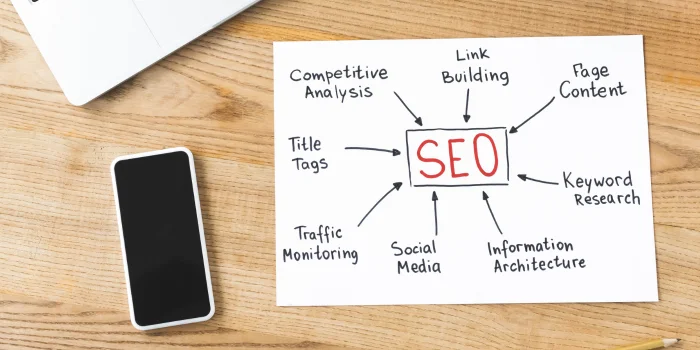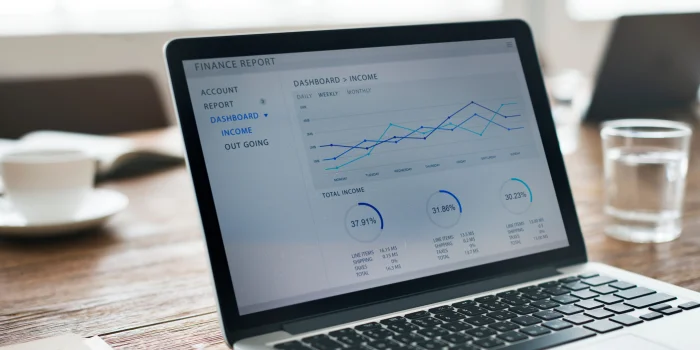Source
Did you know that 96.55% of all web pages get zero search traffic from Google?
(Ahrefs)
That means the vast majority of content is virtually invisible to users. However, you can easily rise above your competitors and capture the traffic they are missing out on through search optimization and targeting the right keywords.
Here are 8 essential steps to create search-optimized content to help you rank higher and drive more organic traffic.
Step 1: Keyword Research
Source
Why Keyword Research Matters
While others fail to optimize their content effectively, you can capture valuable traffic by strategically targeting the right keywords—putting your content in front of the audience your competitors overlook.
When done correctly, keyword research allows you to:
-
Target specific audiences: By understanding the terms your audience uses, you can create content that speaks directly to their needs.
For example, if you’re a SaaS company offering project management software, targeting keywords like "best project management tools" or "top software for team collaboration" ensures you’re reaching users actively looking for solutions.
-
Identify opportunities: Keyword research helps you spot gaps in your competitors’ content strategies. For instance, if a competitor ranks for high-volume keywords but neglects long-tail variations, you can capitalize on those to capture niche traffic.
How to Conduct Effective Keyword Research & Outrank Your Competitors
To conduct effective keyword research, you need to use reliable tools and follow a structured approach. Here’s how:
-
Use Keyword Research Tools: Tools like
Google Keyword Planner or
Ubersuggest
are essential for discovering relevant keywords. These tools provide data on search volume, keyword difficulty, and competition levels.
-
Identify Primary Keywords: Primary keywords are broad terms with high search volume and direct relevance to your business. For example, if you are in the fitness industry, a primary keyword might be "best workout routines." These keywords often have high competition but can drive substantial traffic when targeted effectively.
-
Focus on Long-Tail Keywords: Long-tail keywords are extra specific phrases that clearly reflect user intent (e.g., "best workout routines for beginners"). These typically have lower search volumes but are easier to rank for and often convert better because they target users further down the purchase funnel.
-
Competitor Keyword Analysis: Analyzing your competitors’ keyword strategies can reveal valuable insights. Search optimization tools allow you to see which keywords your competitors rank for and where there might be gaps in their content strategy. For example, if a competitor ranks well for "project management software" but not for "best project management software for small teams," you can target that niche.
Pro Tip: Balancing Search Volume and Competition
Choosing the right search optimization keywords requires balancing search volume with competition. High-volume keywords may bring more traffic but are often highly competitive. On the other hand, low-volume keywords may be easier to rank for but generate less traffic.
To find this balance:
- Look for keywords with moderate search volume (e.g., 500-5,000 searches per month) and low-to-moderate competition scores.
- Use metrics like Keyword Difficulty (KD) scores from your preferred keyword research tool. A KD score between 30-50 is typically considered manageable for most businesses.
- Prioritize long-tail keywords with lower competition but strong intent—these often offer quicker wins while still driving relevant traffic.
Step 2: Understanding Search Intent: Writing for Your Audience
What is Search Intent?
Search intent, also known as keyword intent, refers to the purpose behind a user’s search query. Understanding this intent is crucial for creating content that meets users' needs and ranks well on search engines. There are three main types of search intent:
-
Informational Intent: Users are looking for information or answers to questions. For example, someone searching "how to improve SEO rankings" is looking for educational content.
-
Navigational Intent: Users are trying to seek a particular website or page. For instance, a query like "Facebook login" indicates the user wants to navigate directly to Facebook.
-
Transactional Intent: Users are ready to make a purchase or take a specific action. A query like "buy running shoes online" shows clear intent to complete a transaction.
Aligning Content with User Intent
To create content that is in line with the search intent, you must analyze the top-ranking pages for the target keywords you’ve picked. These pages give insight into what users expect when they perform a search. For example:
-
If most of the top results for a keyword are blog posts, it suggests informational intent.
-
If they are product pages, the intent is likely transactional.
By understanding what type of content ranks well, you can tailor your own content accordingly. For example:
-
Informational intent: Create detailed guides, how-to articles, or educational blog posts.
-
Navigational intent: Optimize landing pages or homepage content.
-
Transactional intent: Focus on product descriptions, landing pages with clear calls-to-action (CTAs), and comparison pages.
Pro Tip: Mapping Keywords to the Marketing Funnel
When it comes to search optimization, search intent also varies depending on where users are in the buyer’s journey. The marketing funnel consists of three stages:
-
Awareness Stage (Top of Funnel): Users are identifying their problem but aren’t yet aware of solutions. Keywords here often include phrases like "how to," "tips," or "why." For example, a user might search "how to improve team productivity." Content at this stage should be educational and help users understand their problem.
-
Consideration Stage (Middle of Funnel): Users know their problem and are evaluating potential solutions. Keywords include terms like "best tool," "solutions," or "services." For instance, someone in this stage might search for "best project management software." Content like case studies, comparisons, and guides work well here.
-
Decision Stage (Bottom of Funnel): Users are ready to buy and are comparing specific products or services. Keywords include terms like "buy," "review," or "trial." A query such as "buy CRM software" reflects transactional intent, so your content should focus on conversion—such as product demos or free trials.
Step 3: Structuring Your Content for Search Optimization
Source
Creating a Clear Outline
Structuring your content with headings (H1, H2, H3) is crucial for both readability and search optimization. Headings provide a clear hierarchy that helps users and search engines understand the flow of information on your page.
For users, well-organized content allows them to quickly find the information they need, improving their experience and reducing bounce rates. For search engines, a clear structure makes it easier to crawl and index your content, which can boost your rankings.
Correct headings can improve your SEO by making your content more readable and user-friendly. If users can’t quickly find what they’re looking for, they’re likely to leave your site, which increases bounce rates—something search engines take into account when ranking pages.
Therefore, structuring your content with descriptive headings not only helps users but also signals to search engines that your content is well-structured plus relevant.
Optimizing Headings with Keywords
When it comes to optimizing headlines for SEO, it's essential to use primary and secondary keywords naturally within your headings. Your H1 should include the main keyword as it signals the primary topic of the page.
Subheadings (H2, H3) should also include relevant keywords but in a way that flows naturally within the context of the section.
It is recommended to use keywords in 30-75% of your subheadings (H2 and H3) for optimal results. However, avoid keyword stuffing—overusing keywords can make your content feel forced and harm readability. Instead, focus on placing keywords where they make sense contextually.
For example, if you're writing an article about "content marketing strategies," use variations like "effective content marketing strategies" or "best practices for content marketing" in your subheadings.
Pro Tip: Scannable Content
Making your content scannable is critical for user engagement. Research shows that most online readers scan rather than read word-for-word.
According to the Nielsen Norman Group, scannable content improves usability by 47%. To make your content scannable:
- Use short paragraphs (2-3 sentences).
- Break down briefs with bullet points or numbered lists.
- Include relevant images or videos to add visual variety.
- Highlight key points in bold or italics.
This approach increases dwell time on your page—another factor that can positively impact SEO rankings.
Step 4: Writing High-Quality Content That Converts
What Makes Content "High Quality"?
High-quality content is defined by its ability to be authoritative, informative, and engaging. It fosters your brand as a trusted source while providing valuable, actionable insights to your audience.
In fact, 75% of users judge a website’s credibility based on the quality of its design and content. To achieve this, your content must be well-researched, accurate, and aligned with your audience's needs.
Authoritative content often includes data-driven insights, case studies, or expert quotes to back up claims. This not only builds trust but also enhances your content’s relevance and ranking potential.
For example, including statistics such as “a well-executed user interface can increase conversion rates by 200%” adds credibility and demonstrates that your content is based on real-world data.
Tips for Writing Comprehensive Content for Search Optimization
To ensure your content thoroughly addresses the user’s query, aim for long-form articles that are 1,000+ words. Studies show that long-form content tends to rank higher in search engines because it provides more in-depth information and keeps users engaged longer.
However, length alone isn’t enough—your content must be comprehensive and structured logically. Here are some tips:
-
Use Data-Driven Insights: Incorporate statistics and case studies to support your points. For instance, mentioning a statistic like “78% of online customers won’t return after a bad user experience” can emphasize the importance of good UX in conversion-focused content.
-
Expert Quotes: Including quotes from industry leaders or experts can further establish authority. This not only adds credibility but also makes your content more shareable.
Pro Tip: Focus on User Experience (UX)
A good UX can boost website conversion rates by up to 400%. Here’s how you can enhance UX in your content:
-
Improve Readability: Break up long paragraphs with subheadings, bullet points, and visuals. Users tend to scan rather than read every word—so make it easy for them to find key information quickly.
-
Add Visuals: Use relevant images, infographics, or videos to break the monotony of text-heavy pages. Visuals not only improve engagement but also help users retain information better.
-
Clear Calls-to-Action (CTAs): Every piece of high-quality content should guide the reader toward the next step—whether it’s signing up for a newsletter or making a purchase.
Step 5: On-Page SEO Optimization: The Technical Side
Source
Key On-Page SEO Elements
-
Title Tag: According to research, title tags can directly influence click-through rates (CTR), with the top three Google search results receiving 54.4% of all clicks.
So ensure your title tag includes your primary keyword and is under 60 characters to avoid truncation in search results. A compelling, keyword-rich title tag can significantly improve your rankings and CTR.
-
Meta Description: Keep meta descriptions under 160 characters and include your primary keyword to align with user intent. Well-crafted meta descriptions will give users a clear reason to visit your page.
-
Optimizing URLs & Alt Text:
-
URLs: Keep URLs short, descriptive, and keyword-rich. For example, a URL like “example.com/seo-tips” is more effective than “example.com/p1234.”
-
Alt Text: Alt text is essential for image SEO and accessibility. Include relevant keywords to help search engines understand the image content, which can improve your rankings in Google Image searches.
Pro Tip: Internal Linking Strategy
Internal links help distribute link equity across your site, boosting the SEO value of linked pages. Use descriptive anchor text and link to relevant pages to enhance user navigation and signal content importance to search engines.
For example, linking from a high-authority blog post to a new article can improve the new page’s ranking potential.
Step 6: Technical SEO Considerations for Better Rankings
Mobile-Friendliness & Page Speed
Mobile optimization is critical since 59% of all internet traffic comes from mobile devices. If your site isn’t mobile-friendly, it may not rank well on Google’s mobile-first index. Make sure responsive design and fast loading times on mobile devices to retain users.
Improving Page Load Times
Page speed is a key ranking factor. Google reports that 53% of users abandon sites that take longer than 3 seconds to load. To optimize speed:
- Compress images without losing quality.
- Minimize CSS and JavaScript files.
- Use browser caching tools to reduce load times.
Pro Tip: Use Google Tools
Tools like Google PageSpeed Insights or Lighthouse can help monitor and improve your site’s performance by analyzing Core Web Vitals such as Largest Contentful Paint (LCP) and Cumulative Layout Shift (CLS). A one-second improvement in page speed can increase conversions by up to
27%.
Step 7: Leverage Backlinks and Social Signals
Backlinks from authoritative websites can significantly boost your search rankings. In fact, a study by Backlinko found that the number of referring domains is one of the strongest ranking factors in Google’s algorithm. Here’s how you can leverage backlinks effectively:
- Build Relationships with Industry Influencers: Connect with influencers or authoritative sites in your niche for guest posting or collaborations. For instance, getting backlinks from top cooking blogs or media outlets can significantly improve your search optimization if you run a cooking site.
- Guest Posting on Reputable Sites: Guest posts on high-authority websites not only provide backlinks but also expose your content to a broader audience.
- Encourage Social Sharing: While social signals like shares and likes aren’t direct ranking factors, they can still indirectly impact SEO. Social shares increase content visibility, which can lead to more backlinks and traffic over time.
Step 8: Monitoring Performance & Updating Content Regularly
Source
Tracking key metrics and regularly updating your content is crucial for maintaining and improving your search rankings.
- Track Key Metrics with Analytics Tools: Use tools like Google Analytics and Google Search Console to monitor organic traffic, bounce rates, time on page, and keyword rankings. For example, Google Search Console allows you to see which keywords are driving traffic and how your pages are performing in search results. This data helps you identify underperforming content that needs optimization.
- Updating Old Content for Better Rankings: Refreshing outdated content can significantly improve rankings. Updating old blog posts with new data, fixing broken links, and optimizing for new keywords can boost SEO performance.
In Conclusion
Creating search-optimized content is no longer optional—it’s essential for driving organic traffic and staying competitive.
By following these 8 steps, from thorough keyword research to building backlinks, you can ensure your content ranks higher on search engines and reaches the right audience.
With the right SEO strategy, your content will not only attract more visitors but also convert them into loyal customers.
Ready to take your content strategy to the next level?
At Lexiconn, we specialize in crafting high-quality, search-optimized content that drives results. Let our team of experts help you boost your rankings and grow your online presence. Contact us today for a free 30-minute consultation to start optimizing!
or
Visit us at www.lexiconn.in or drop us a line at [email protected]
Boost your Content Strategy.
Download the Free eBook now.
Unlock Generative AI's potential for content marketing success. Unearth its impact on teams and businesses. Witness real-life examples and case studies, showcasing AI-driven content ingenuity.









